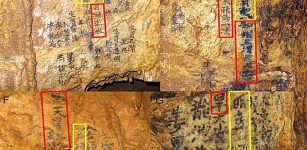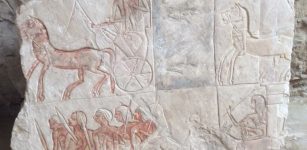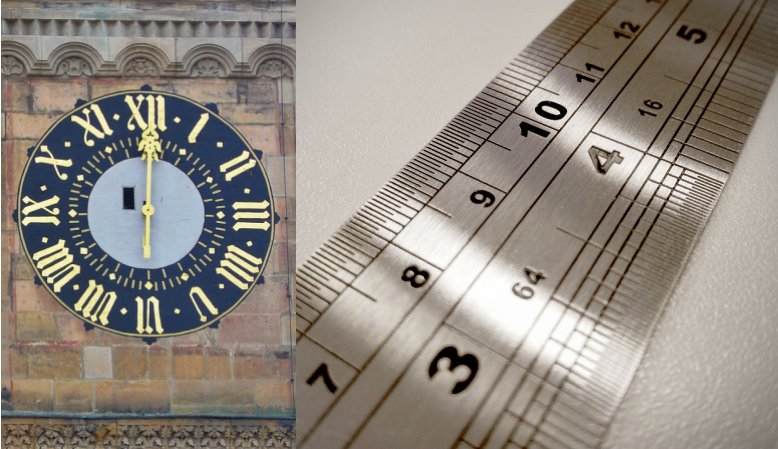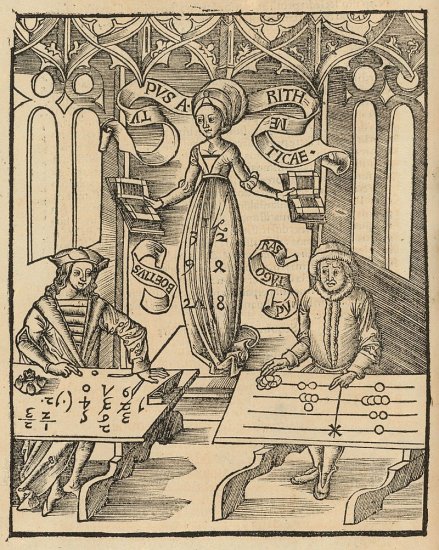Why Did We Abandon Roman Numerals?
Conny Waters - AncientPages.com - It’s often said that we’ve abandoned Roman numerals, which is not entirely true. We can still find Roman numerals on clock’s, monuments, in books, personal titles and other places. We just don’t use the Roman numerals often because we switched to the Arabic numeric system.
Credit: Public Domain
Romans numerals are a numerical system composed of seven Latin letters. Ancient Romans adapted the numerical systems from Etruscan numerals.
The symbols are I, V, X, L, C, D, and M, standing respectively for 1, 5, 10, 50, 100, 500, and 1,000 in the Hindu-Arabic numeral system.
Ancient Romans and Europeans used Roman numerals for a long time, but it’s was not a practical numerical system. For example, Roman Numerals do not have a zero (0). Arabic numbers have ten digits (from 0-9) and they give us the opportunity to produce very large numbers.
See also:
Why Is The Three Golden Balls Symbol For A Pawn Shop Connected To The Medici Family?
Torquetum: Sophisticated Medieval Astronomical Instrument
Nomenclator: Ancient Living-Human Calendar And Address Book
Merkhet – An Ancient Egyptian Timekeeping Instrument
Leonardo Fibonacci (c. 1170 – c. 1250), an Italian mathematician who is considered the most talented Western mathematician of the Middle Ages introduced the Hindu–Arabic numeral system in the Western World primarily through his composition in 1202 of Liber Abaci (Book of Calculation).
While visiting North Africa, Fibonacci learned the Hindu–Arabic numeral system and he quickly understood this system was better suitable for mathematics. It should be noted that “the Arabs did not immediately adopt the Hindu zero, because it resembled their 5; they used the superscript dot as serving their purposes fairly well.” (The Hindu-Arabic numerals- David Eugene Smith and Louis Charles Karpinski)
Through his book he managed to convince many European mathematicians to abandon Roman numerals and start using the Hindu-Arabic system instead.
Calculating-Table by Gregor Reisch: Margarita Philosophica, 1503. The woodcut shows Arithmetica instructing an algorist and an abacist (inaccurately represented as Boethius and Pythagoras). There was keen competition between the two from the introduction of the Algebra into Europe in the 12th century until its triumph in the 16th. Credit: Public Domain
To keep track of their sales and expenses, ancient European merchants relied on counting beads and Roman numerals were only used to document the results. Even though the Hindu Arabic system offered many advantages, for some reason salesmen were rather reluctant towards it, and it took time before the new numerical system became accepted.
In The Introduction of 'Arabic' Numerals in European Accounting, John W. Durham explained that “the preference for Roman numerals continued among bookkeepers until the sixteenth century, hundreds of years after the introduction of Arabic numbers. The preferences is well-known, but the causes are not.”
In time people understood that by switching to the Hindu–Arabic numeral system it was possible to solve complicated mathematical problems and counting became much easier. The new system permitted mathematical operations to be made on arbitrarily large numbers.
Written by Conny Waters – AncientPages.com Staff Writer
Copyright © AncientPages.com All rights reserved. This material may not be published, broadcast, rewritten or redistributed in whole or part without the express written permission of AncientPages.com
Expand for referencesLouis Charles Karpinski and David Eugene Smith - The Hindu-Arabic Numerals
Durham, John W. "THE INTRODUCTION OF "ARABIC" NUMERALS IN EUROPEAN ACCOUNTING." The Accounting Historians Journal 19, no. 2 (1992): 25-55. http://www.jstor.org/stable/40698081.
More From Ancient Pages
-
 Samurai Swords: Katana And Wakizashi And Their Long Tradition
Ancient Traditions And Customs | Aug 6, 2018
Samurai Swords: Katana And Wakizashi And Their Long Tradition
Ancient Traditions And Customs | Aug 6, 2018 -
 3D Facial Landmarks Reveal Columbus’ Cannibal Claims Were No Myths But True Accounts
Archaeology | Jan 15, 2020
3D Facial Landmarks Reveal Columbus’ Cannibal Claims Were No Myths But True Accounts
Archaeology | Jan 15, 2020 -
 Fragment Of Unique Ancient Greek Terracotta Statue Uncovered In Underwater Diggings
Archaeology | Mar 26, 2017
Fragment Of Unique Ancient Greek Terracotta Statue Uncovered In Underwater Diggings
Archaeology | Mar 26, 2017 -
 Florida’s Ancient Underwater Burial Site Much Older Than Previously Thought
Archaeology | Jun 24, 2019
Florida’s Ancient Underwater Burial Site Much Older Than Previously Thought
Archaeology | Jun 24, 2019 -
 Robert The Bruce: Mighty King Of Scots And Great Scottish Hero
Featured Stories | Oct 13, 2016
Robert The Bruce: Mighty King Of Scots And Great Scottish Hero
Featured Stories | Oct 13, 2016 -
 Incredible Treasure Discovered In The Secret Chamber Of The Great Pyramid 1,200 Years Ago May Offer Proof Of Long-Lost Scientific Knowledge
Ancient Mysteries | Dec 31, 2018
Incredible Treasure Discovered In The Secret Chamber Of The Great Pyramid 1,200 Years Ago May Offer Proof Of Long-Lost Scientific Knowledge
Ancient Mysteries | Dec 31, 2018 -
 ‘Graffiti’ Found On The Walls Of Dayu Cave, China
News | Aug 25, 2015
‘Graffiti’ Found On The Walls Of Dayu Cave, China
News | Aug 25, 2015 -
 Silver And Bronze Coins Discovered In Ancient Roman Fort Apsaros, Georgia
Archaeology | Jul 23, 2018
Silver And Bronze Coins Discovered In Ancient Roman Fort Apsaros, Georgia
Archaeology | Jul 23, 2018 -
 Ancient Copy Of Jesus’ Secret Teachings To His Brother James Discovered – First Apocalypse And Future Events Described
Artifacts | Dec 2, 2017
Ancient Copy Of Jesus’ Secret Teachings To His Brother James Discovered – First Apocalypse And Future Events Described
Artifacts | Dec 2, 2017 -
 Unusual Scenes Painted On The Walls Inside Egyptian Tomb Of General Iwrkhy – Discovered
Archaeology | May 10, 2018
Unusual Scenes Painted On The Walls Inside Egyptian Tomb Of General Iwrkhy – Discovered
Archaeology | May 10, 2018 -
 Ancient Volcanic Eruption Was Not A Catalyst To Early Homo Sapiens Cultural Innovations – Study finds
Archaeology | Jul 8, 2024
Ancient Volcanic Eruption Was Not A Catalyst To Early Homo Sapiens Cultural Innovations – Study finds
Archaeology | Jul 8, 2024 -
 Witch Of Endor – A Biblical Ghost Story Or A Woman With Supernatural Powers?
Featured Stories | Jul 9, 2021
Witch Of Endor – A Biblical Ghost Story Or A Woman With Supernatural Powers?
Featured Stories | Jul 9, 2021 -
 Native American Sun Dance: Important Ceremony Of The Plains Indians Of North America
Ancient History Facts | May 20, 2016
Native American Sun Dance: Important Ceremony Of The Plains Indians Of North America
Ancient History Facts | May 20, 2016 -
 New Light On Appearance Of Scythians In Northern Black Sea Region
Archaeology | Mar 11, 2017
New Light On Appearance Of Scythians In Northern Black Sea Region
Archaeology | Mar 11, 2017 -
 Remarkable Underground City Of Nushabad: A Masterpiece Of Ancient Architecture
Ancient Technology | Nov 17, 2015
Remarkable Underground City Of Nushabad: A Masterpiece Of Ancient Architecture
Ancient Technology | Nov 17, 2015 -
 London’s Underground Rivers Were Deliberately Hidden
Featured Stories | Oct 8, 2018
London’s Underground Rivers Were Deliberately Hidden
Featured Stories | Oct 8, 2018 -
 Eriu: Powerful Irish Goddess And Sacred Uisneach Hill Where She And God Lugh Are Buried
Celtic Mythology | Feb 15, 2019
Eriu: Powerful Irish Goddess And Sacred Uisneach Hill Where She And God Lugh Are Buried
Celtic Mythology | Feb 15, 2019 -
 Mysterious And Sacred Intihuatana Stone Of The Inca Was More Than Just An Astronomy Calendar
Archaeoastronomy | May 8, 2018
Mysterious And Sacred Intihuatana Stone Of The Inca Was More Than Just An Astronomy Calendar
Archaeoastronomy | May 8, 2018 -
 Unique 8,000 Year-Old Child Burial Reveals Its Secrets
Archaeology | Nov 3, 2020
Unique 8,000 Year-Old Child Burial Reveals Its Secrets
Archaeology | Nov 3, 2020 -
 Pharaoh Hor Aha – 1st Dynasty Ruler Of Ancient Egypt Who Founded The City Of Memphis And May Have Been The Legendary Menes
Featured Stories | Jun 23, 2018
Pharaoh Hor Aha – 1st Dynasty Ruler Of Ancient Egypt Who Founded The City Of Memphis And May Have Been The Legendary Menes
Featured Stories | Jun 23, 2018


